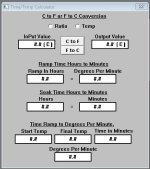In my PLC I have all my formulas in Celsius, but at the HMI they can enter Celsius or Fahrenheit. The problem I am having is when I calculate my temperature deviation for alarms and someone enters in using Fahrenheit. 1 deg. Fahrenheit converts to a – 17.22222 Deg. Celsius. So I end up trying to subtract -17.22222 from Setpoint Deg. Celsius
Actual <= Temp Setpoint - Neg_Deviation_Temp = Alarm
70 deg. C <= 80 – -17.222 = Alarm
Actual <= Temp Setpoint - Neg_Deviation_Temp = Alarm
70 deg. C <= 80 – -17.222 = Alarm








